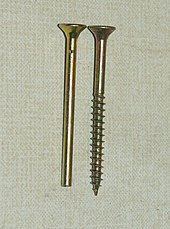Thread rolling
Thread rolling , often also called thread rolling , is a variant of rolling and is used to produce threads . The process is mainly used in the manufacture of screws .
The forming is based on the generation of compressive stresses by tools that are reproduced on the workpiece.
Procedure
There are different types of thread rolling, which are differentiated according to the type of tools used:
- Flat jaw rolling : The raw part is machined between two profiled flat jaws that are moved linearly to one another.
- Segment rollers : The blank is machined between a segment-shaped profile surface and a roller, which rotates in the tread surface.
- Grooving process and through- feed axial thrust process : The blank is machined between two profiled rollers.
advantages
Thread rolling is much faster and, in the case of large quantities, cheaper than other methods of producing threads, namely thread cutting . Further advantages of thread rolling are:
- The grain boundaries are different than when cutting not interrupted
- Surface hardening is achieved through cold forming
- Press-polished thread flanks
- Higher wear resistance
- Reduced notch sensitivity
- No chips , therefore less material required
literature
- Heinz Tschätsch, Jochen Dietrich: Practice of forming technology: work processes, machines, tools . 10th edition. Vieweg + Teubner, 2010, ISBN 978-3-8348-1013-7 , pp. 58 ( books.google.com [accessed December 9, 2010]).
- Fritz Klocke , Wilfried König : Manufacturing process 4 - forming , Springer, 5th edition, pp. 302-310.

